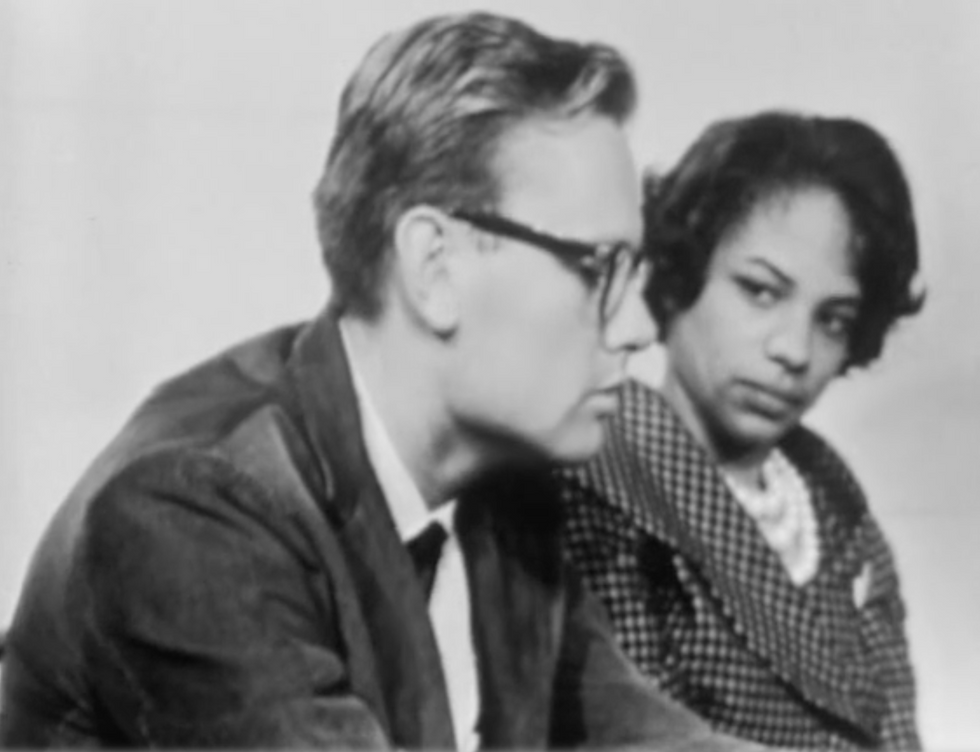Hawkins Field, Jackson Airport, Jackson, MS, July 21, 1961 - Freedom Ride Encounter 42
- arthausdetroit
- Jul 19, 2022
- 4 min read
Nine riders pictured below (from first person, first row): James Carey, Reverend Francis Geddes, Joseph Gumbiner, Mary and Russell Jorgensen, Rabbi Allan Levine, Orville Luster, Charles Sellers, and Reverend John Washington.
Many white Freedom Riders joined in the civil rights struggle as college students or working adults. But there were those whose motivation began at a younger age. This was true for Charles Sellers.
Today, we call it "woke" when someone's eyes are open to how things really are. The biblical terminology that's long been used in the church for the same thing is a little more dramatic.
Sellers went to an NAACP meeting in a black church when he was in high school. He described the message he heard that day as, "the most powerful" he had ever heard.
" I was one of only two or three white people in their enormous congregation and I guess this was a "scales falling from my eyes kind of experience that I never got over. I was in dissent with my society from that time on." Scales falling off of one's eyes kinda sums up nicely what happens to any of us when we're rudely awakened to truth, or a veil of illusion is lifted.
Sellers became active in CORE during the civil rights movement. Back in 1950, he obtained his Ph.D. in American history from UNC, Chapel Hill, where he was civically aware and active, Sellers, subsequently became a history professor at U.C. Berkeley, where he remained for his entire career. That is where he became a member of the local CORE chapter. Gateway to the Freedom Ride campaign of 1961.

Greyhound, Nashville, TN, to Jackson, MS, July 21, 1961 - Freedom Ride 43
Four riders pictured above (from second person, third row): Paul Breines, Donna Garde, Joel Greenberg, and Ruth Moskowitz.
...years ago I started to pick up trash in my neighborhood...People in the neighborhood know me. Someone made me a sweatshirt that says White Trash Collector.
This is the sort of feeling I had when I went on the Freedom Ride. I thought, "We can change the world." I still think I can change the world, but it takes the form of keeping my neighborhood clean... -Paul Breines (Breach of Peace, Etheridge, 2018)

Trailways, Nashville, TN, to Jackson, MS, July 23, 1961 - Freedom Ride 44
Seven riders pictured above (from first row, l to r), Albert Huddleson, Candida Lall Pugh, Morton Linder, Peggi Oakley, Michael Powell, Alexander Weiss, and Ralph Williams.
Candida Lall Pugh, born and raised in San Francisco, Boston and L.A., was working in San Francisco as a secretary at the time of the rides. She has written a novel, based on her experiences as a Freedom Rider. Bridge of the Single Hair is still available for purchase.
Veterinarian Morton Linder described his motivation for going [on the Freedom Ride] as, "a feeling of -- maybe of guilt, maybe obligation. I did feel it was a window of time when I could do something."
Peggi Oakley met her future spouse on this Freedom Ride. Pages 189 and 191 of Breach of Peace (Etheridge, 2018) will tell you whom, and of the many roads they traveled afterward.
When interviewed, by an FBI agent, after her arrest, Oakley asserted that she was standing up for a constitutional amendment. She reported that, serious as day, the agent responded, "Don't you know nobody believes in those things anymore?"
Hawkins Field, Jackson Airport, Jackson, MS, July 24, 1961 - Freedom Ride 45
Four riders pictured above (last 4 images, from fourth person, second row): Alphonso Petway, Kredelle Petway, Reverend Matthew Petway, and Cecil Thomas.
Reverend Matthew Petway was a black World War II veteran -- one of many -- who fully comprehended the irony of loyally fighting for freedom abroad that was denied to him at home. After returning from war he became a very involved activist, Reverend Petway was plenty motivated by the time the Freedom Ride campaign came to fruition. He learned about civil disobedience and had taken training in it at Highlander Folk School in Tennessee before the ride of July 24, 1961.
He went on the July 24 ride with is children, Kredelle and Alphonso. Kredelle was in college, but Alphonso? He was barely halfway through high school.
As with most Freedom Riders, after the ride, Kredelle and Alphonso would continue -- in two very different ways -- in public service. You can learn more about them, and other participants in Ride 45, here.
As for Cecil Thomas, he had been instrumental in building support for the civil rights movement, particularly for bus boycotts. A book footnote reveals his direct connection to a figure of historic significance
Cecil Thomas (1917-1969), born in Frankfort, Ohio, received his B.A. (1939) from Cedarville College in Ohio and his Ph.D. (1949) from Ohio State University. He and his wife, Fran Thomas, first became acquainted with Coretta Scott while teaching at Lincoln School in Marion, Alabama, between 1941 and 1943. Fran worked closely with Coretta and her older sister as their music instructor. They continued their relationship with Coretta Scott while she pursued music studies at Antioch College.
This footnote is connected to Thomas's letter in The Papers of Martin Luther King, Jr. Volume III: Birth of a New Age, December 1955-December 1956. The letter reveals the high regard he held for Dr. King and fellow activists. And it allows a peek at the trust and high regard he was given in return.
SOURCE FOR QUOTES on this page, except those pertaining to Cecil Thomas: Breach of Peach, by Eric Etheridge (Vanderbilt, 2018).


Comments